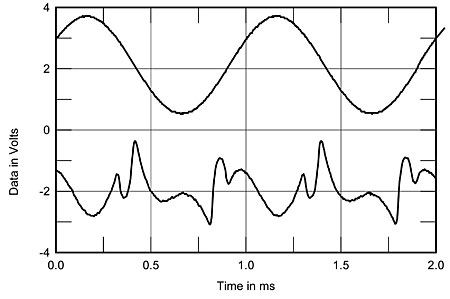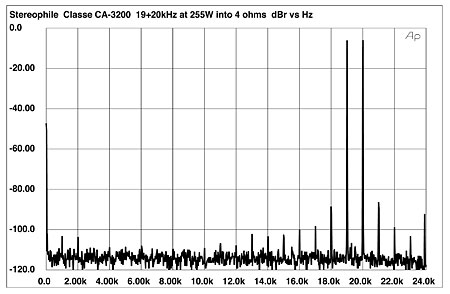| Columns Retired Columns & Blogs |
Classé CA-3200 three-channel power amplifier Measurements
Sidebar 3: Measurements
Before performing any measurements, I preconditioned the Classé CA-3200 by running it for 60 minutes at one-third power with all three channels driven into 8 ohms. At the end of that time, the THD+noise had dropped from 0.0024% to 0.00195%, but the top panel and the heatsinks were way too hot to touch, the curved front panel was around 50°C, and a noticeable draft of hot air rose from the top-panel vents over the center channel's internal heatsink. If this amplifier is to be used in a custom installation, it should be well ventilated.
The voltage gain into 8 ohms was to specification at 29dB and well matched across the three channels. The amplifier was non-inverting (ie, it preserved absolute phase) for both unbalanced and balanced input signals; the XLRs for the latter are wired with pin 2 hot. The input impedance for the unbalanced jacks was 70–75k ohms from 20Hz to 20kHz, and exactly double that for the balanced inputs.
The output impedance was a very low 0.047 ohm at low and middle frequencies, rising slightly but inconsequentially to 0.075 ohm at 20kHz. As a result, any modification of the amplifier's frequency response by the way in which the partnering loudspeaker's impedance changes with frequency will be minimal. For example, with our standard simulated speaker, the response changed by just ±0.05dB (fig.1, top trace at 2kHz). The amplifier's response was flat to 20kHz into 8 and 4 ohms, but dropped by 0.2dB at 20kHz into 2 ohms. The small-signal bandwidth was wide, the –3dB point into 8 ohms lying at 150kHz for both balanced and unbalanced drive. Correlating with that, the waveform of a 10kHz squarewave showed very small risetimes with only the faintest hint of overshoot (fig.2).

Fig.1 Classé CA-3200, frequency response at 2.83V into (from top to bottom at 2kHz): simulated loudspeaker load, 8, 4, 2 ohms (0.5dB/vertical div., left & center channels solid, right channel dashed).

Fig.2 Classé CA-3200, small-signal 10kHz squarewave into 8 ohms.
The CA-3200's channel separation (fig.3) was better than 95dB between all possible pairs of channels at 1kHz. It did decrease at the frequency extremes, however. The amplifier's wideband, unweighted signal/noise ratio (ref. 2.83V into 8 ohms and taken with the input shorted) was good rather than great, at 73.9dB balanced and 71.2dB unbalanced. Reducing the measurement bandwidth to 22kHz improved both ratios to 91.4dB, while switching in an A-weighting filter gave further improvement, to 93.9dB.

Fig.3 Classé CA-3200, channel separation (from top to bottom at 10kHz): L–C (solid), C–L (dashed); L–R (solid), R–L (dashed); C–R (dashed), R–C (solid) (10dB/vertical div.).
With one channel driven, the CA-3200 easily exceeded its specified output power (fig.4). With clipping defined as 1% THD+N, the Classé clipped at 250W into 8 ohms (24dBW) and 450W into 4 ohms (23.5dBW). The 2 ohm trace in this graph cuts off at 661W (22.2dBW), which is when the CA-3200 went into protection and the active channel's front-panel blue LED blinked red. After resetting the amplifier, I determined that the overload had done no damage.

Fig.4 Classé CA-3200, distortion (%)vs 1kHz continuous output power into (from bottom to top at 100W): 8, 4, 2 ohms, one channel driven.
The shapes of the traces in fig.4 indicates that the distortion remains under the noise floor below a few tens of watts, so I plotted how the THD+N percentage changed with frequency at 17V RMS. The results are shown in fig.5: while the THD remains very low below 1kHz even into 2 ohms, it does rise at higher frequencies, presumably due to the decrease in the circuit's open-loop gain at high frequencies. However, the THD level is still low in absolute terms.

Fig.5 Classé CA-3200, THD+N (%)vs frequency at 17V into (from bottom to top): 8, 4, 2 ohms (left & center channels, solid, right channel dashed).
At low frequencies, the CA-3200's distortion content was predominantly second and third harmonic (fig.6). But at higher currents and frequencies, not only did the third harmonic increase in level (fig.7), but some higher-order harmonics appeared (fig.8). Even so, intermodulation distortion was very low, even at an output level just below visual clipping on the oscilloscope screen (fig.9).

Fig.6 Classé CA-3200, spectrum of 50Hz sinewave, DC–1kHz, at 100W into 8 ohms (linear frequency scale).

Fig.7 Classé CA-3200, spectrum of 1kHz sinewave, DC–10kHz, at 200W into 4 ohms (linear frequency scale).

Fig.8 Classé CA-3200, 1kHz waveform at 140W into 2 ohms (top), 0.0058% THD+N; distortion and noise waveform with fundamental notched out (bottom, not to scale).

Fig.9 Classé CA-3200, HF intermodulation spectrum, DC–24kHz, 19+20kHz at 255W peak into 4 ohms (linear frequency scale).
Overall, this is excellent measured performance, though the increase in high-order THD at high current levels did raise my eyebrows.—John Atkinson
- Log in or register to post comments




































